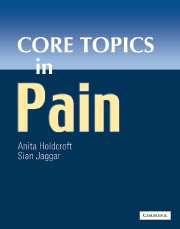Book contents
- Frontmatter
- Contents
- Contributors
- Preface
- Acknowledgements
- Foreword
- General abbreviations
- Basic science abbreviations
- PART 1 BASIC SCIENCE
- 1 Overview of pain pathways
- 2 Peripheral mechanisms
- 3 Central mechanisms
- 4 Pharmacogenomics and pain
- 5 Peripheral and central sensitization
- 6 Inflammation and pain
- 7 Nerve damage and its relationship to neuropathic pain
- 8 Receptor mechanisms
- PART 2 PAIN ASSESSMENT
- Section 2a Pain measurement
- Section 2b Diagnostic strategies
- PART 3 PAIN IN THE CLINICAL SETTING
- Section 3a Clinical presentations
- Section 3b Pain syndromes
- PART 4 THE ROLE OF EVIDENCE IN PAIN MANAGEMENT
- PART 5 TREATMENT OF PAIN
- Section 5a General Principles
- Section 5b Physical treatments
- Section 5c Pharmacology
- Section 5d Psychosocial
- PART 6 SUMMARIES
- Glossary
- Index
7 - Nerve damage and its relationship to neuropathic pain
from PART 1 - BASIC SCIENCE
Published online by Cambridge University Press: 10 December 2009
- Frontmatter
- Contents
- Contributors
- Preface
- Acknowledgements
- Foreword
- General abbreviations
- Basic science abbreviations
- PART 1 BASIC SCIENCE
- 1 Overview of pain pathways
- 2 Peripheral mechanisms
- 3 Central mechanisms
- 4 Pharmacogenomics and pain
- 5 Peripheral and central sensitization
- 6 Inflammation and pain
- 7 Nerve damage and its relationship to neuropathic pain
- 8 Receptor mechanisms
- PART 2 PAIN ASSESSMENT
- Section 2a Pain measurement
- Section 2b Diagnostic strategies
- PART 3 PAIN IN THE CLINICAL SETTING
- Section 3a Clinical presentations
- Section 3b Pain syndromes
- PART 4 THE ROLE OF EVIDENCE IN PAIN MANAGEMENT
- PART 5 TREATMENT OF PAIN
- Section 5a General Principles
- Section 5b Physical treatments
- Section 5c Pharmacology
- Section 5d Psychosocial
- PART 6 SUMMARIES
- Glossary
- Index
Summary
Introduction
The nociceptive system was previously thought of as a hard—wired system, mediating information about tissue damage to the brain in a fixed and static manner. However, injury to the peripheral or central nervous system (CNS) triggers a cascade of changes, which alter the structure and function of the nervous system. The result is a high degree of plasticity in those systems that mediate information about tissue damage, with neuronal modifications occurring at several levels of the neuraxis from the peripheral receptor to the cortex. These changes after nerve damage may result in peripheral or central neuropathic pain.
Neuropathic pain is characterized by pain in an area with sensory loss corresponding to the damaged nerve or central lesion. The qualities may be burning, smarting, shooting, aching, and pricking. The pain may be accompanied by dysesthesia (unpleasant abnormal sensations), allodynia (the elicitation of pain in the affected area by non-noxious stimulation with light touch or innocuous cold or warmth), and hyperalgesia (increased pain response to a normal noxious stimulus). Other features frequently seen in neuropathic pain are wind-up-like pain (abnormal temporal summation of pain), aftersensations (pain continuing after stimulation has ceased), and referred pain (pain felt in a place apart from the stimulated area).
- Type
- Chapter
- Information
- Core Topics in Pain , pp. 43 - 48Publisher: Cambridge University PressPrint publication year: 2005



